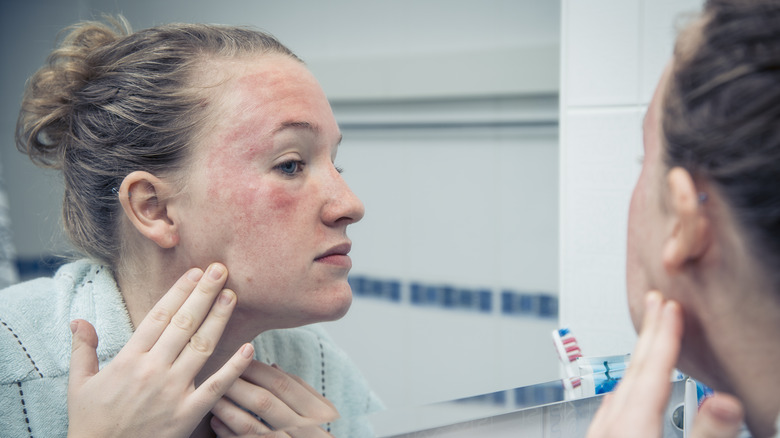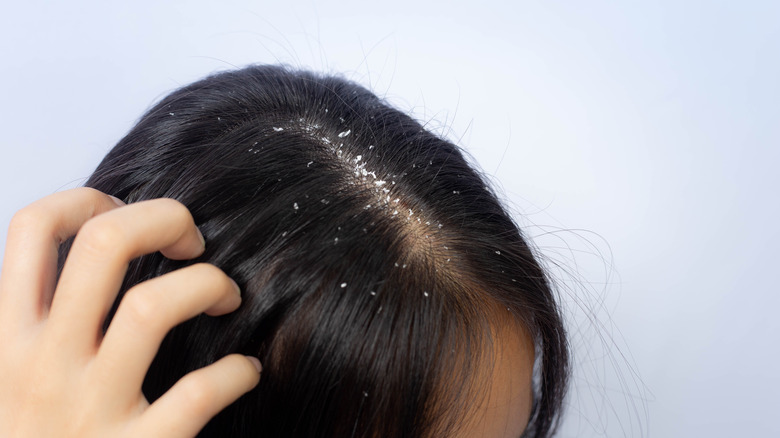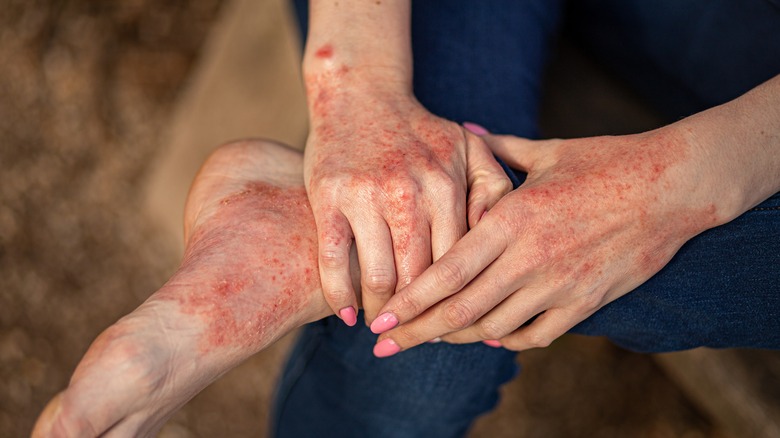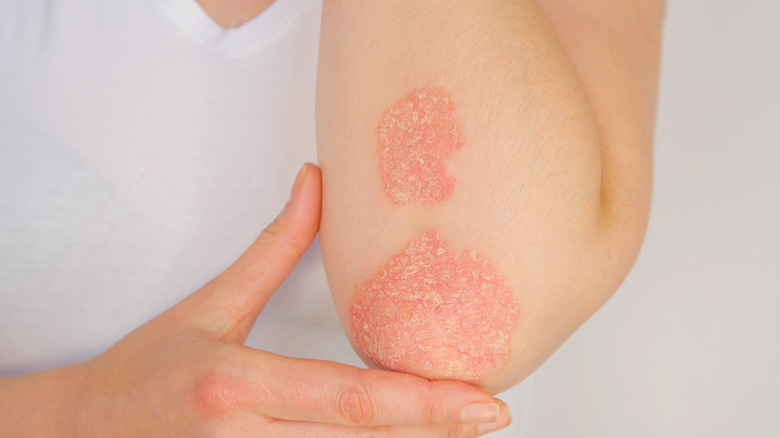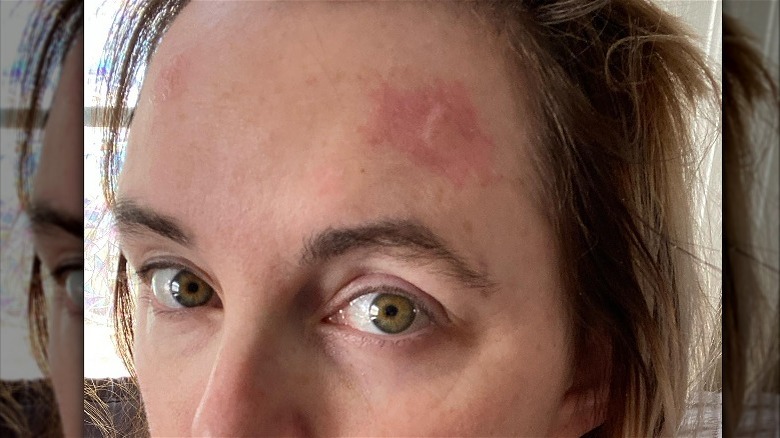5 Common Causes Of Scaly Skin Spots
When you suffer from rough, scaly patches of skin, it can feel like you're the only one in the world going through it. But luckily, you're not — there are plenty of reasons why skin might become inflamed and irritated, and none of them have to do with the universe having a personal vendetta against you. Plus, most of the time, it's easily fixable.
From environmental factors to our diet to autoimmune responses, there are several potential causes of dry, rough patches, each with its appropriate treatment. Once you can determine which cause you're dealing with, you can begin fixing the issue and getting back to smooth, comfortable, touchable skin.
A dermatologist can narrow down the harder-to-identify skin responses, but if you don't have ready access to one, this is a great place to start. So, grudges from the cosmos aside, here are some reasons you might be dealing with scaly skin patches.
Dry skin, plain and simple
Let's start with problems with the simplest solution: dry skin. Everyone's skin reacts differently to dryness — some skin gets tight and cracked, others get ashy, and some deal with patches of scaly, irritated skin. All of these responses are normal, albeit uncomfortable.
Dry skin can be caused by many factors, according to the Mayo Clinic. This includes factors like the environment, such as low humidity, cold, or windy climates. But dry skin can also be caused by too much indoor heat, excessive bathing, stripping soaps or detergents, medical treatments, or the natural aging process.
To treat your dry skin, start with a gentle moisturizer that can protect your skin's outermost barrier throughout the day. If you plan on going outdoors, make sure your moisturizing product has an SPF no lower than 30. You can also try gentler soaps, limit your body's exposure to hot water, and stay hydrated (yep, the water you drink makes its way to your skin, too).
Seborrheic dermatitis (a.k.a. dandruff)
Another reasonably straightforward cause of dry, patchy skin is seborrheic dermatitis, better known as dandruff. These patches can be harder to find since they're often covered with hair, but as anyone who has suffered from dandruff knows, you can still feel them. Dandruff is classified as a chronic form of eczema, per the National Eczema Association, and is believed to affect three to ten out of every 100 people.
We often associate dandruff with the scalp, but seborrheic dermatitis can also affect the upper back, nose, and scalp — anywhere there are many sebaceous glands. It is thought to be exacerbated by a type of yeast that lives on the skin's surface. When this yeast overgrows, the immune system responds in a way that causes inflammation, itchiness, flaking, and peeling.
While there are prescription dandruff shampoos available, there are plenty of viable OTC dandruff shampoo options as well. Find a shampoo that contains one or all of the following ingredients: pyrithione zinc, selenium sulfide; ketoconazole 1%; tar; or salicylic acid. Stress management and proper sleep hygiene can also reduce the symptoms of seborrheic dermatitis.
Eczema or atopic dermatitis
Perhaps the most well-known eczema is atopic dermatitis, caused by an overactive immune system affecting the skin barrier. The skin becomes patchy, dry, and itchy, and many people with atopic dermatitis note comorbid allergy symptoms like asthma, food sensitivities or intolerances, and sinus issues.
Eczema rough patches commonly appear where our skin rubs together throughout the day — think elbows, knees, or other creases. The National Eczema Foundation cites a filaggrin deficiency as a lead cause of eczema, which refers to a protein called filaggrin that helps your skin retain moisture. Other non-genetic causes could include exposure to dry, cold air, detergents, metals, dust mites, or certain fabrics.
For skin irritations like eczema that pertain to the body's natural immune response, it's best to seek treatment from a licensed dermatologist. There are several forms of eczema treatment, including corticosteroids, OTC products, and holistic options. Just like each person's eczema is different, so is their treatment.
Psoriasis, often confused with eczema
Psoriasis is another skin condition that causes painful, itchy, dry patches that appear red and scaly. Because of its visual symptoms, it's often confused with atopic dermatitis, but the diseases' causes — and treatments — are not the same. Per the CDC, psoriasis manifests most commonly on elbows, palms, the face, scalp, and knees.
The CDC lists psoriasis as an autoimmune disease. However, the National Psoriasis Foundation classifies it as immune-mediated, meaning psoriasis' root cause is still unknown, though it appears to be related to the immune system. During a psoriasis flare-up, the immune system speeds up the skin cell turnover rate without shedding, causing the dead skin cells to gather on the skin's surface and cause red or silver scales.
Unfortunately, this inflammation can start disaffecting other parts of the body and can lead to psoriatic arthritis (joints) or plaque psoriasis (the mouth). Psoriasis is another skin condition that is best treated by a dermatologist, but there are things you can do to limit your symptoms, including stress management, opting for non-irritating clothing, and incorporating soothing CBD into your skincare routine.
Actinic keratosis
Last on the list of scaly skin culprits — and arguably the most critical to treat — is actinic keratosis (AK). Common AK locations include the face, scalp, neck, and forearms, and although the symptoms might look similar to other dry skin causes, only AK has high odds of turning cancerous. According to the Mayo Clinic, untreated AK has about a five to 10% chance of becoming a squamous cell carcinoma, a type of skin cancer.
This is because AK is caused by repeated exposure to the sun's harmful UV rays. Sun damage builds up over time, causing the skin to form scaly patches, most commonly after the age of 40. Because AK can turn into skin cancer if left untreated, it's imperative that you get a doctor's opinion on whether you're dealing with AK or a different, visually similar condition.
Treatment for AK removal includes scraping, freezing, lasering, and chemically treating the affected area. Preventative efforts to avoid AK include limiting your sun exposure, always wearing sunscreen (even if you plan on relaxing in the shade), and avoiding tanning beds.
